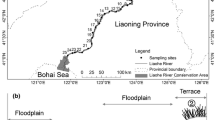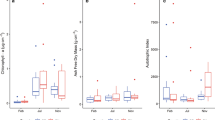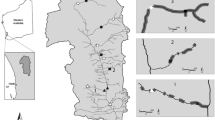Abstract
This study was carried out to evaluate the linkages among herbaceous plant biomass (i.e., aboveground and litter biomasses) and diversity (Shannon-Wiener index) in riparian and non-riparian areas, land use, and lotic water quality (which included first- and second-order natural streams, a canal, and a reach of a lowland river). Herb stands selected were free from anthropogenic disturbances such as farming and construction activities for a period of 3 years (this was the dominant and peak frequency of disturbances of the study area). The results suggested that herb indicators are good representatives of the land use. However, land use explanations for herb indicators were complex and not universal for all lotic waters. The correlations between herb indicators and water quality were strong for the low-order natural streams. In these streams, herb indicators explained >36 % of the total variation with several statistically significant herb indicators. However, the large river section showed weak correlations. Furthermore, the canal’s hydrology (connectivity to sea) seemed to be more influential in shaping its water quality. This study demonstrated that the rehabilitation works with a span of 3–4 years using herbs in riparian and/or non-riparian areas could significantly improve water quality of low-order streams with natural origin.











Similar content being viewed by others
References
Anbumozhi, V., Radhakrishnan, J., & Yamaji, E. (2005). Impact of riparian buffer zones on water quality and associated management considerations. Ecological Engineering, 24, 517–523.
APHA/American Water Works Association/Water Environment Federation. (1998). Standard methods for the examination of water and wastewater (20th ed.). Washington D.C: American Public Health Association.
Ashton, M. S., Gunatilleke, C. V. S., SinghakumaraB, M. P., & Gunatilleke, I. A. U. N. (2001). Restoration pathways for rain forest in southwest Sri Lanka: a review of concepts and models. Forest Ecology and Management, 154, 409–430.
Bio diversity secretariat (2008). The study of the faunal diversity in Galle district, southern Sri Lanka. Final report. Wild life conservation society, Galle, Sri Lanka.
Bowers, K., & Boutin, C. (2008). Evaluating the relationship between floristic quality and measures of plant biodiversity along stream bank habitats. Ecological Indicators, 8, 466–475.
Chambers, P. A., Meissner, R., Wrona, F. J., Rupp, H., Guhr, H., Seeger, J., et al. (2006). Changes in nutrient loading in an agricultural watershed and its effects on water quality and stream biota. Hydrobiologia, 556, 399–415.
Coe, H. J., Wei X., & Kiffney, P. M. (2013). Linking forest harvest and landscape factors to benthic macroinvertebrate communities in the interior of British Columbia. Hydrobiologia (In press).
De Marco, P., & Resende, D. C. (2010). Adult odonate abundance and community assemblage measures as indicators of stream ecological integrity: a case study. Ecological Indicators, 10, 744–752.
Doležal, J., Yakubov, V., & Hara, T. (2013). Plant diversity changes and succession along resource availability and disturbance gradients in Kamchatka. Plant Ecology, 214, 477–488.
Dosskey, M. G., Vidon, P., Gurwick, N. P., Allan, C. J., Duval, T. P., & Lowrance, R. (2010). The role of riparian vegetation in protecting and improving chemical water quality in streams 1. Journal of the American Water Resources Association, 46, 261–277.
Dutilleul, P. (1993). Modifying the t test for assessing the correlation between two spatial processes. Biometrics, 49, 305–314.
Ehrenfeld, J. G. (2004). The expression of multiple functions in urban forested wetlands. Wetlands, 24(4), 719–733.
Ehrenfeld, J. G. (2008). Exotic invasive species in urban wetlands: environmental correlates and implications for wetland management. Journal of Applied Ecology, 45(4), 1160–1169.
Ehrenfeld, J. G., Cutway, H. B., Hamilton, R., & Stander, E. (2003). Hydrologic description of forested wetlands in northeastern New Jersey, USA—an urban/suburban region. Wetlands, 23(4), 685–700.
Enanga, E. M., Shivoga, W. A., Maina-Gichaba, C., & Creed, I. F. (2011). Observing changes in riparian buffer strip soil properties related to land use activities in the River Njoro watershed, Kenya. Water, Air, & Soil Pollution, 218, 587–601.
Giller, P. S., & Malmqvist, B. (1999). The biology of streams and rivers. New York: Oxford University Press.
Gomes, P. I. A., & Asaeda, T. (2009). Spatial and temporal heterogeneity of Eragrostis curvula in the downstream flood meadow of a regulated river. Annales de Limnologie International Journal of Limnology, 45, 181–193.
Graves, J. H., Peet, P. K., & White, P. S. (2006). The influence of carbon—nutrient balance on herb and woody plant abundance in temperate forest understories. Journal of Vegetation Science, 17, 217–226.
Holling, C. S. (1973). Resilience and stability of ecological systems. Annual Review of Ecology and Systematics, 1–23.
King, R. S., Baker, M. E., Whigham, D. F., Weller, D. E., Jordan, T. E., Kazyak, P. F., et al. (2005). Spatial considerations for linking watershed land cover to ecological indicators in streams. Ecological Applications, 15, 137–153.
Kiwango, Y., Moshi, G., Kibasa, W., & Mnaya, B. (2013). Papyrus wetlands creation, a solution to improve food security and save Lake Victoria. Wetlands Ecology and Management, 21, 147–154.
Lepš, J., & Šmilauer, P. (2003). Multivariate analysis of ecological data using CANOCO. Cambridge, UK: Cambridge university press.
Miller, J. D., Schoonover, J. E., Williard, K. W., & Hwang, C. R. (2011). Whole catchment land cover effects on water quality in the Lower Kaskaskia River watershed. Water, Air, & Soil Pollution, 221, 337–350.
Moran, M. A. (1984). Influence of adjacent land use on understory vegetation of New York forests. Urban Ecology, 8(4), 329–340.
Naiman, R. J., & Décamps, H. (1997). The ecology of interfaces: riparian zones. Annual Review of Ecology and Systematics, 28, 621–658.
Nakamura, K., Tockner, K., & Amano, K. (2006). River and wetland restoration: lessons from Japan. BioScience, 56(5), 419–429.
Osborne, L. L., & Wiley, M. J. (1988). Empirical relationships between land use/cover and stream water quality in an agricultural watershed. Journal of Environmental Management, 26, 9–27.
Pickett, S. T. A., Cadenasso, M. L., Grove, J. M., Nilon, C. H., Pouyat, R. V., Zipperer, W. C., et al. (2001). Urban ecological systems: Linking terrestrial ecological, physical, and socioeconomic components of metropolitan areas. Annual Review of Ecology and Systematics, 32, 127–157.
Pickett, S. T., Cadenasso, M. L., Grove, J. M., Groffman, P. M., Band, L. E., Boone, C. G., et al. (2008). Beyond urban legends: an emerging framework of urban ecology, as illustrated by the Baltimore Ecosystem Study. BioScience, 58(2), 139–150.
Rheinhardt, R., Brinson, M., Meyer, G., & Miller, K. (2012). Integrating forest biomass and distance from channel to develop an indicator of riparian condition. Ecological Indicators, 23, 46–55.
Ringold, P. L., Van Sickle, J., Bollman, M., Welty, J., & Barker, J. (2009). Riparian forest indicators of potential future stream condition. Ecological Indicators, 9, 462–475.
Sims, J. T., Simard, R. R., & Joern, B. C. (1998). Phosphorus loss in agricultural drainage: Historical perspective and current research. Journal of Environmental Quality, 27, 277–293.
Sliva, L., & Williams, D. D. (2001). Buffer zone versus whole catchment approaches to studying land use impact on river water quality. Water Research, 35, 3462–3472.
Sponseller, R. A., Benfield, E. F., & Valett, H. M. (2001). Relationships between land use, spatial scale and stream macroinvertebrate communities. Freshwater Biology, 46, 1409–1424.
TerBraak, C.J.F., & Smilauer, P. (2002). CANOCO Reference Manual and CanoDraw for Windows User’s Guide: Software for Canonical Community Ordination (version 4.5), Microcomputer Power (Ithaca), New York.
Tripp, R., Wijeratne, M., & Piyadasa, V. H. (2005). What should we expect from farmer field schools? A Sri Lanka case study. World Development, 33, 1705–1720.
Wickramathilake, B. A. K., Weerasinghe, T. K., & Ranwala, S. M. W. (2013). Impacts of woody invader Dillenia suffruticosa (Griff.) Martelli on physio-chemical properties of soil and, below and above ground flora. Journal of Tropical Forestry and Environment, 3(2), 66–75.
Acknowledgments
Authors would like to thank D.A.M. Nimal Shanthi of the University of Ruhuna, S. Jayasinghe and T.U.L. Liyanage of Ocyana Consultants (Pvt) Ltd. (subsidiary of SMEC (Pvt) Ltd.), and GIS Division of Irrigation Department, Sri Lanka. This research was partly funded by the Research Fund, Faculty of Engineering, University of Ruhuna“, and Research Grants Council Funds of Hong Kong (Project numbers 529610 and 527312). We are indebted to the anonymous reviewers for their useful comments and suggestions which drastically improved this manuscript.
Author information
Authors and Affiliations
Corresponding author
Rights and permissions
About this article
Cite this article
Gomes, P.I.A., Wai, O.W.H., Kularatne, R.K.A. et al. Relationships Among Anthropogenic Disturbances Representative Riparian and Non-Riparian Herbaceous Indicators (Biomass and Diversity), Land Use, and Lotic Water Quality: Implications on Rehabilitation of Lotic Waters. Water Air Soil Pollut 225, 2060 (2014). https://doi.org/10.1007/s11270-014-2060-4
Received:
Accepted:
Published:
DOI: https://doi.org/10.1007/s11270-014-2060-4




